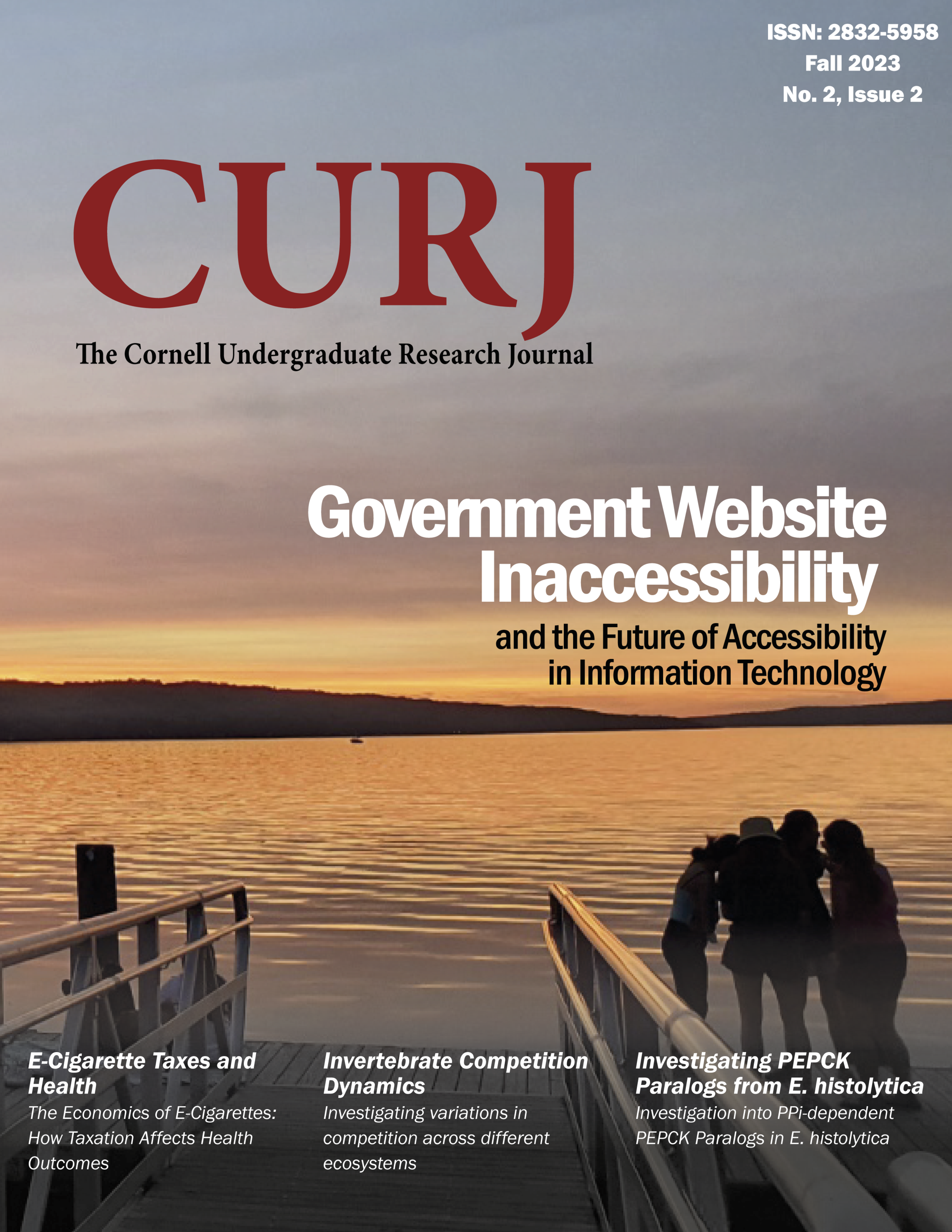Abstract
Although the government has made efforts to mandate the accessibility of federal websites, such guidelines have ultimately failed at addressing the needs of the disability community. The law requiring the viewability of federal websites, Section 508, is enforced by the Access Board, a government agency. However, the guidelines for evaluating website accessibility are vague and do not include provisions for people with cognitive disabilities. Such insubstantial laws deny disabled people essential government benefits, opportunities to interact with the government, and knowledge about the legislation that affects them. Upon examining this literature, the practical impacts of exclusionary language were revealed. After reviewing relevant legislation, I explored research papers detailing the disparities caused by inaccessible legislation. Lastly, I examined current projects to develop my policy recommendations. I contend that stricter legislation and website testing boards led by people with disabilities will promote the proper administration of accessibility laws. I found that the approach employed by the Department of Justice to determine the accessibility of federal websites excludes the varied ways that disabled people interact with technology. The Department of Justice must clearly present and frequently release its accessibility assessments to promote accountability. Further, accessibility measurements must be led by people with disabilities, and the testing boards should be a coalition of communities, internet accessibility tools, and legislators to promote the agency of the most impacted. The institution of these initiatives would remove barriers restricting information from the people that the laws are intended to affect.
References
Abrams, A. (2022, September 27). None of These Major Midterm Campaign Websites Are
Fully Accessible to Disabled Voters. Time.
https://time.com/6216100/midterm-candidate-websites-disabled-access/
Bai, Y., Grzeslo, J., Min, B., & Jayakar, K. (2020). Accessibility of Local Government
Websites: Influence of Financial Resources, County Characteristics and Local Demographics. Universal Access in the Information Society, 20, 851-861. https://doi.org/10.1007/s10209-020-00752-5
Björkman, M. (2022). Inter-tool Reliability of Three Automated Web Accessibility Evaluators.
In Jiang, L., Jonsson, A., & Vanheé, L. (Eds.), Proceedings of Umeå’s 25th Student Conference in Computing Science (pp. 15-25). Umeå Universitet. https://webapps.cs.umu.se/uminf/reports/2022/001/part1.pdf#page=21
Blanck, P. (2014). eQuality: The Struggle for Web Accessibility by Persons with Cognitive
Disabilities. Cambridge University Press.
EPPackageLocationID=2296011.3283350.29400939&epcustomerid=s9001366
Ekstrand, V. (2017). Democratic Governance, Self-Fulfillment and Disability:
Web Accessibility under the Americans with Disabilities Act and the First Amendment.
Communication Law and Policy, 22(4), 427-458. https://doi.org/10.1080/10811680.2017.1364918
Jenkins, A, & Vu, Minh. (2023, February 27). Long Overdue Report Shows Deficient
Accessibility for Many Federal Websites. Seyfarth Shaw LLP.
https://www.adatitleiii.com/2023/02/long-overdue-report-shows-deficient-accessibility-fo
r-many-federal-websites/
Miami Lighthouse for the Blind and Visually Impaired. (2022). The 2022 ADA Compliance
Meter Report.
https://www.miamilighthouse.org/Docs/The2022ADAComplianceMeterReport.pdf
Mingus, M. (2017, April 12). Access Intimacy, Interdependence and Disability Justice. Leaving
Evidence.
Nondiscrimination on the Basis of Disability; Accessibility of Web Information and Services of
State and Local Government Entities, 81 Fed. Reg. 28657 (March 9, 2016) (to be codified at 28 C.F.R. pt. 35). https://www.federalregister.gov/documents/2016/05/09/201610464/nondiscrimination-on-the basis-of-disability-accessibility-of-web-informationand-services-of-state
Jaeger, P. (2011). Disability and the Internet: Confronting a Digital Divide. Lynne Rienner
Publishers.
Johnson, A., & Castro, D. (2021). Improving Accessibility of Federal Government Websites.
Information Technology & Innovation Foundation. https://www2.itif.org/2021-improving-accessibility-federal-government-websites.pdf
Lazar, J., Goldstein, D. F., & Taylor, A. (2015). Ensuring Digital Accessibility through Process
and Policy. Morgan Kaufmann. https://learning.oreilly.com/library/view/ensuring-digital-
accessibility/9780128007105/?ar=
Maisel, J., & Ranahan, M. (2022, April 29). Beyond Accessibility To Universal Design.
Whole Building Design Guide. https://www.wbdg.org/design-objectives/accessible/beyond-accessibility-universal-design
Pavlicko, R. (2021). The Future of the Americans with Disabilities Act: Website Accessibility
Litigation After COVID-19. Cleveland State Law Review, 69(4), 953-980. https://engagedscholarship.csuohio.edu/clevstlrev/vol69/iss4/9
Price v. City of Ocala, 375 F. Supp. 3d 1264, Doc. 1, para. 33-34 (M.D. Fla. 2019).
https://casetext.com/case/price-v-city-of-ocala
Reid, B. (2020). Internet Architecture and Disability. Indiana Law Journal, 95(2), 591-648.
https://www.repository.law.indiana.edu/ilj/vol95/iss2/6
Reno, Attorney General of the United States, et al. v. American Civil Liberties Union et al., 521 U.S. 844 (1997). https://supreme.justia.com/cases/federal/us/521/844/case.pdf
Section 508 ICT Testing Baseline. (2022, January). Appendix B - Section 508 ICT Testing Baseline Change Log. US Access Board and Section 508.gov. https://ictbaseline.access-board.gov/ChangeLog3/
Section 508 ICT Testing Baseline. (2022, January). Introduction. US Access Board and Section 508.gov. https://ictbaseline.access-board.gov/introduction/
Section508.gov. (2017, December 12). Do Section 508 Accessibility Standards Apply to My Website? General Services Administration. https://www.section508.gov/blog/do-section-508-accessibility-standards-apply-to-mywebsite/
Section508.gov. (2020, July). IT Accessibility Laws and Policies. General Services Administration. https://www.section508.gov/manage/laws-and-policies/
Regents of the University of Minnesota. (2023). Accessibility 102: The WAVE Accessibility Tool.
https://www.d.umn.edu/itss/training/online/wave/
U.S. Access Board. (n.d.). About the U.S. Access Board. https://www.access-board.gov/about/.
U.S. Department of Justice. (2023). Section 508 Report to the President and Congress: Accessibility of Federal Electronic and Information Technology. U.S Department of Justice & U.S. General Services Administration. https://www.justice.gov/crt/page/file/1569331/download

This work is licensed under a Creative Commons Attribution 4.0 International License.
Copyright (c) 2023 Kassidy Slaughter

